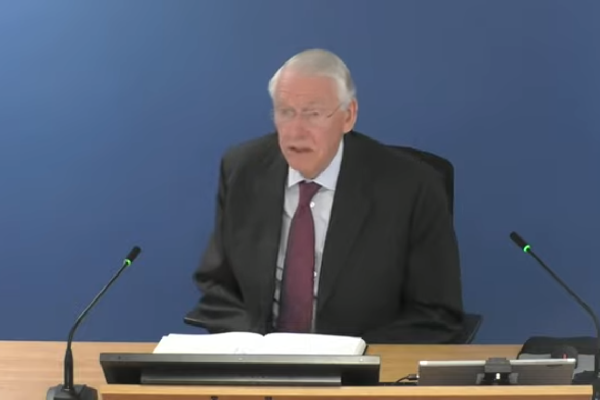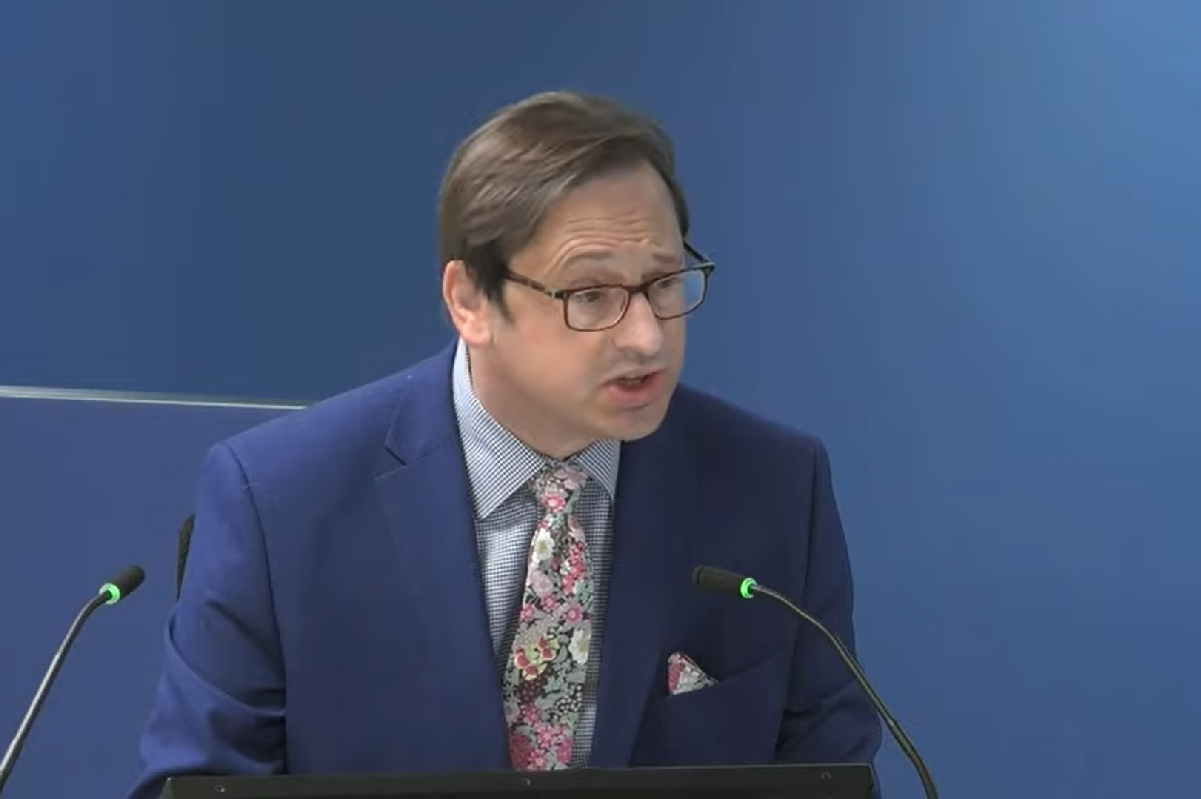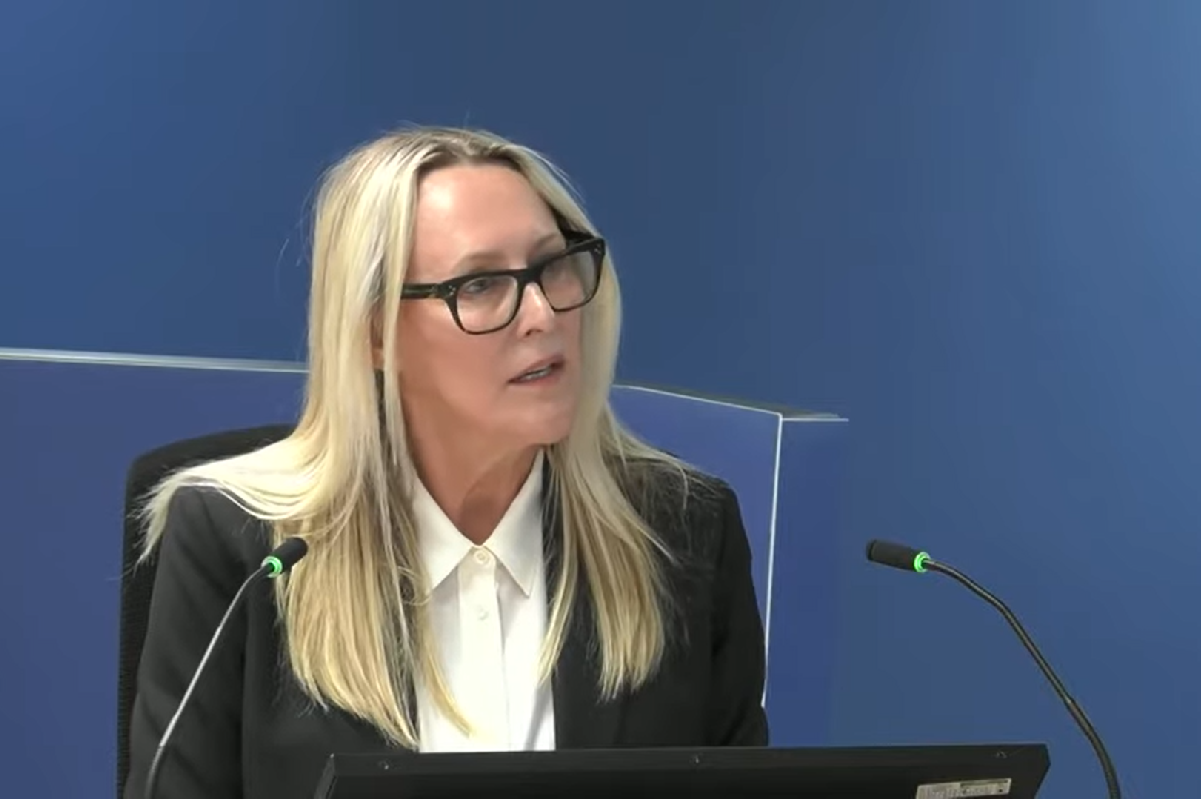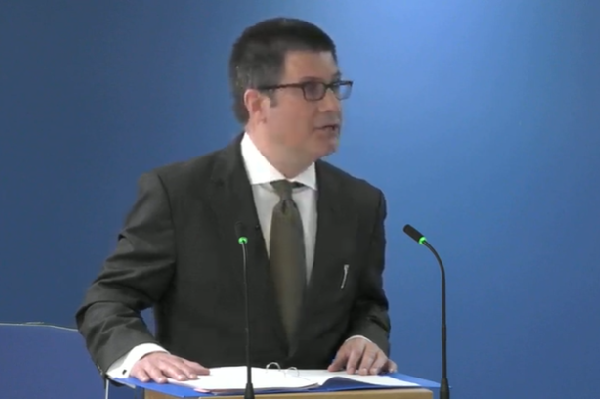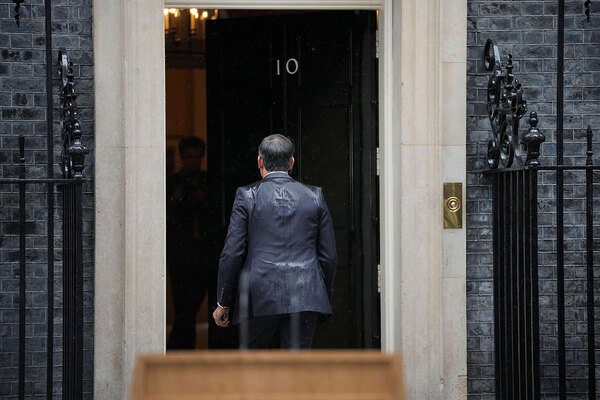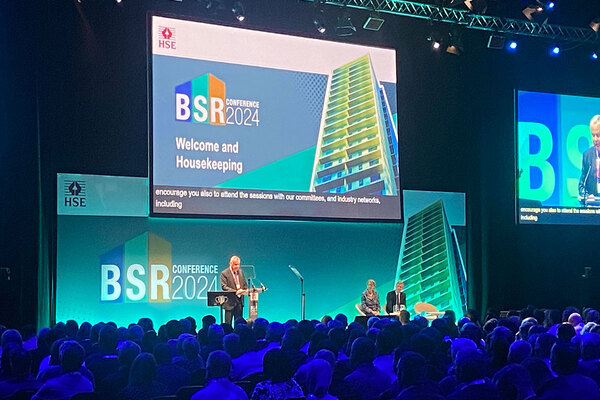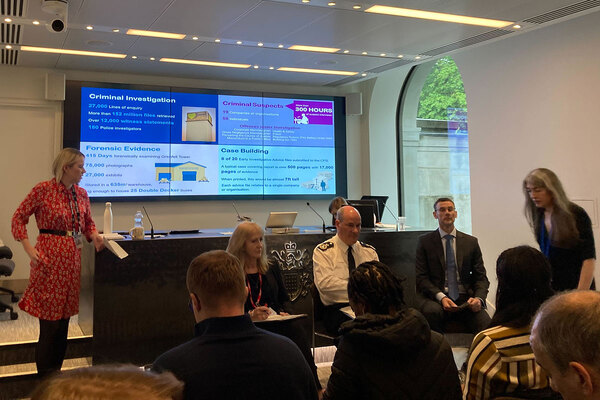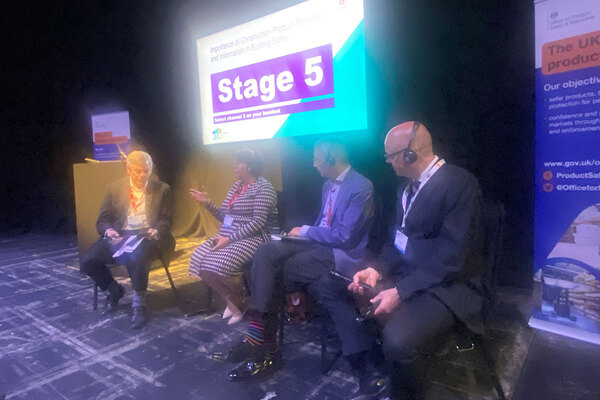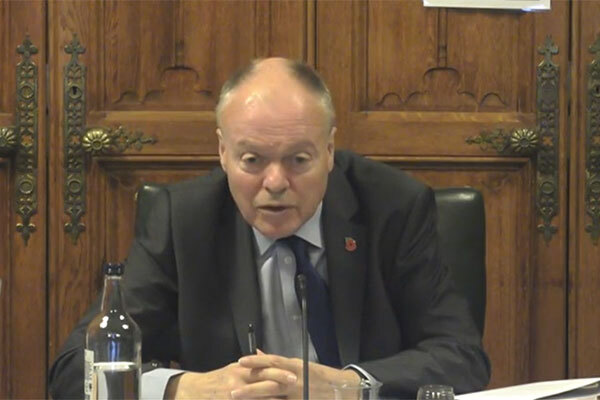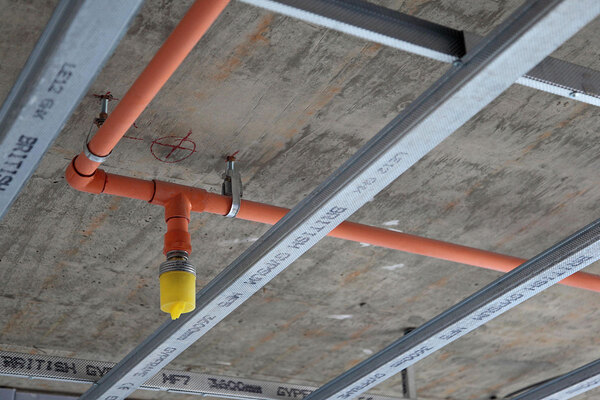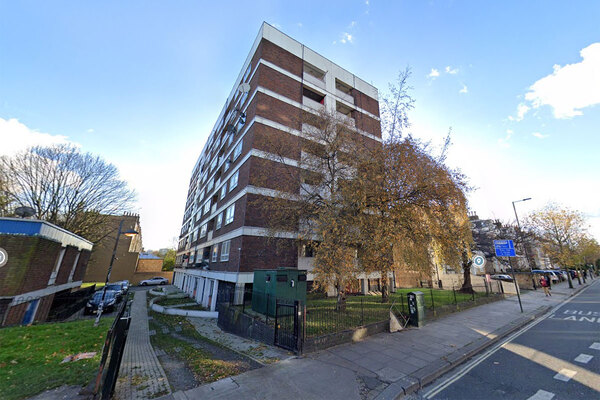Grenfell Tower Inquiry diary week 82: ‘Their chance to hear about the circumstances in which their loved ones died is the culmination of five years of waiting’
The Grenfell Tower Inquiry moved into its final module this week, with evidence relating to the circumstances in which the victims died. Peter Apps reports
After two-and-a-half years, the Grenfell Tower Inquiry’s second phase is finally nearing the end of its oral evidence sessions.
With evidence relating to central government, the corporates, the firms involved in the refurbishment, the London Fire Brigade (LFB) and the social landlords complete, the inquiry is now turning to the victims of the fire.
Over the next three weeks, the inquiry will hear presentations from family lawyers relating to those who died in the blaze, in order to help establish as much as it can about the precise circumstances of their deaths.
This evidence is inevitably distressing and the inquiry is careful to issue ‘trigger warnings’ at the start of each session. While the most harrowing details will not be included in our summaries, it is right to include such a warning here as well.
Why is this part of the inquiry happening and what will it include?
The coroner for Inner London West has opened and adjourned 70 inquests into the deaths of the victims of the Grenfell Tower fire, pending the conclusion of the inquiry and the publication of its report.
Were these inquests to take place in full, they would represent another long, harrowing legal process for the bereaved families to endure.
But much of this evidence would repeat what is already being considered by the inquiry. So the purpose of this part of the process is to “ensure the inquiry will do all that it properly can… to ensure it finds all the facts which the coroner would need to find when conducting an inquest”, in the words of inquiry chair Sir Martin Moore-Bick (pictured above).
These findings will be published in the final report and it will then be for the coroner, Dr Fiona Wilcox, to decide whether she can adopt them “relieving her and the families of the burden of any further proceedings as far as she is concerned”.
The inquests relate to 70 of the 72 victims of the fire. Logan Gomes, a stillborn baby killed during the fire, is not covered by the provisions of the Coroners Act. Maria del Pilar Burton, known as Pily, died in hospital in January 2018 and no inquest has been opened for her.
The inquiry will still hear a presentation for Logan Gomes, scheduled for 19 July, as it is not constrained by the requirements of the Coroners Act. A description of the circumstances of Ms Burton’s death will be recorded in the final report.
It is important to stress that the two processes – the coroner’s inquest and the public inquiry – remain legally distinct, with different powers and different terms of reference.
Richard Millett QC, lead counsel to the inquiry, explained in an opening statement that the inquiry panel will not be seeking to reach any “coronial conclusion”, which it does not have the jurisdiction to draw.
Coronial conclusions, such as natural causes, accident/misadventure or unlawful killing, are for Dr Wilcox to draw at a later date.
As a result, the evidence presented in this module will “not be seeking to apportion responsibility for the deaths to any specific person, act, event or omission”, Mr Millett said.
Instead, the facts will be presented in an “uncontroversial way” and will “avoid making submissions, arguments or allegations against other core participants”.
These presentations will be given by lawyers acting on behalf of the families and will seek to guide the panel to make findings of fact in the following 10 areas:
- Their name, gender and age
- The number of the flat in which they lived and the floor number
- The background and composition of their household
- What messages, if any, passed between them and the emergency services (or others) and what information was held about them
- Whether the firefighters tried to rescue them
- Where they died
- The time of their death
- Their movements between outbreak of the fire and the time of death
- The medical cause of their death
- Whether they had any vulnerabilities and whether those were known to the Kensington and Chelsea Tenant Management Organisation (KCTMO) or the Royal Borough of Kensington and Chelsea (RBKC)
Mr Millett said: “For many bereaved, their chance to hear about the circumstances in which their loved ones died is the culmination of five years of waiting, five years of material that at times must have seemed very far removed from the ones they lost, who they were and how they died.
“Although we must apply sensible procedures and timekeeping to ensure a process that is fair for all, the individual need to speak and be heard is paramount.”
The module bookends the inquiry – which began its first phase in May 2018 with commemoration hearings for the deceased – with evidence relating to the victims.
‘In my experience, the majority of individuals who die in fires die from inhalation of fire fumes’
The process began with evidence from forensic pathologist Dr Ashley Fegan-Earl (pictured above), who has been involved in mass disasters such as the Paddington rail crash and recent terror incidents in London.
Along with 12 others, he carried out post-mortem investigations on the deceased.
Dr Fegan-Earl explained to the inquiry that the primary causes of death were either recorded as “consistent with the effect of fire” or “inhalation of fire fumes” or similar.
The former category covers victims where their bodies were too seriously damaged by the fire to allow for a traditional post-mortem.
Dr Fegan-Earl said a conclusion of ‘unascertained’ could have been used in these circumstances, but this would have been “an absurdity” given that they were recovered from the tower.
He explained that it was likely all the victims had died from smoke inhalation rather than burns. It was simply that this could not be forensically demonstrated in some of the cases due to the fire damage to the victims, which was likely sustained after they died.
“My view would be overwhelmingly that the deaths were likely inhalation of fire fumes rather than burning by flame,” Dr Fegan-Earl said.
“The cause of ‘consistent with effects of fire’ was given as a general term that was able to encompass the various ranges that were available, while emphasising that caveat that in my view, and certainly in my experience, the majority of individuals who die in fires die from inhalation of fire fumes.”
This is consistent with the views of toxicology expert Professor David Purser, who gave evidence to the inquiry last week.
The inquiry also heard from Gaille MacKinnon (pictured above), a forensic anthropologist who was involved in the post-mortem process.
She has worked on various major disaster, including the Haiti earthquake in 2010 and the World Trade Centre attacks in 2001.
Ms MacKinnon explained that structural concerns with Grenfell Tower resulted in a “considerable time delay” in the process of assessing the evidence and that “sometimes delayed the victim identification process”.
She added that this was “a time constraint” which proved “very difficult for families”.
She talked through the process in detail, including explaining a ‘grand round’ process, which had previously been used at the World Trade Centre.
“Based on the process that you adopted, how confident can you be that you appropriately or properly identified the relevant information in relation to each deceased?” asked Mr Millett.
“Very confident,” replied Ms MacKinnon.
Asked how confident she could be that she had identified the correct number of victims and had not left any human remains behind in the tower unidentified, she said she could be “very confident”.
Asked to explain why, Ms MacKinnon cited “the rigour with which the recoveries and the clearance of the flats following each recovery were undertaken” and the fact that “the recovery spaces were very particular and confined within each flat”.
The story of Flat 205
There were several presentations this week from family lawyers. These included Rania Ibrahim and her children Fethia and Hania; Deborah Lamprell; Jessica Urbano Ramirez; Hamid Kani; Berkti and Biruk Haftom; Raymond Bernard; Abdeslam Sebbar; Hesham Rahman; Husna Begum; Kamru Miah; Mohammed Hamid; Mohammed Hanif; and Rabeya Begum.
The transcripts of all these presentations can be accessed on the inquiry website here.
Our report this week, however, will focus on three presentations relating to five victims who all died in Flat 205 – on the top floor of Grenfell Tower.
This is because this evidence sets out in extraordinarily tragic detail the consequences of one of the key issues the inquiry examined at great length in its third module: the failure to plan for the escape of residents with disabilities.
Those who are following our wider fire safety coverage will know this is a very live policy issue. Most disabled residents in high rises still do not have personal emergency evacuation plans (PEEPs) and the Home Office recently set out an intention to reject the inquiry’s recommendation that providing them should be made a legal requirement.
Particularly in the light of that ongoing and crucial policy debate, it is worth explaining what we heard this week about the last moments of the residents trapped in Flat 205.
‘It is a fact that residents with mobility impairment and family who were not prepared to leave them were trapped’
The first presentation of the week related to Eslah and Mariem Elgwahry, a mother and daughter who were 64 and 27 respectively on the night of the fire.
Eslah, who was born in Egypt, moved into a flat on the 22nd floor of the tower in 1983 with her husband, who died years before the fire. They had two children: Mariem and Ahmed.
Lawyer Danny Friedman QC (pictured above) said Eslah was “a significant figure to many of the younger people born and bred in Grenfell”, noting “how fondly [former resident and survivor] Mohammed Rasoul spoke of her during his evidence”. He added that her surviving son, Ahmed, has “chosen to respect a degree of privacy around his mother, to keep her memory special to the family”.
Mr Friedman provided a photograph to be viewed privately by the panel, and also drew their attention to Ahmed's comments in the commemoration hearing in May 2018 about Eslah's “strength in raising her children after her husband’s death” and “that it was thanks to what she taught them that they were such a close-knit family who always put each other first”.
Mariem was described as “a funny, beautiful, strong, confident, sporty, adventurous and ambitious young woman”, “a wonderful aunt to [Ahmed’s] young son” and “inseparable” from their mother Eslah. Mariem was also Eslah’s primary carer due to her ill health, which is why she still lived in Grenfell Tower.
Mr Friedman said Eslah had “a complex range of health challenges which resulted in difficulty walking and left her reliant on the lift to get to and from” her flat.
“Her mobility problems meant that she was unable to evacuate without assistance via the single stairs in the event of a need to do so,” he said. “[Ahmed] believes Mariem, who was young and fit, could have made it out of the tower, but Mariem would never have left their mother.”
Eslah had told KCTMO of her physical disability in 2015, ticking the relevant box in the tenancy information questionnaire.
As with others, there was no evacuation plan in place for Eslah, nor any communication of her condition to the London Fire Brigade (LFB).
Mr Friedman said that on the night of the blaze, the fire reached the kitchen window of their flat at around 1.26am – meaning it was among the first in the tower to be affected.
Mariem made a phone call to the LFB shortly after 1.30am to report a fire in their kitchen. The two women left their flat and went upstairs to the top floor.
This issue – why a number of residents went upwards rather than descending at this point in the night – is one that remains unclear following the lengthy evidence about the night of the fire from the first phase back in 2018.
Mr Friedman noted that Mariem told her brother in a phone call that the stairwell was blocked by others going upstairs and these residents told them to go up.
There is also evidence from survivor Meron Mekonnen that “a male voice was heard to shout a command for residents to go back”. Mr Friedman said the person shouting “may have been a firefighter”.
He added that firefighters were also engaged in an attempted rescue on Floor 16, which would have resulted in smoke entering the stairwell at this point giving “a perception of danger below”.
“While the full circumstances of the upwards migration will never be known, it is a fact that none of the firefighters present in the building at the time ever unequivocally shouted for residents in the staircase to get out when they had the chance to do so,” Mr Friedman said.
On reaching the 23rd floor, the top of the tower, Eslah and Mariem entered Flat 205 – the home of Mohamed and Shakila Neda and their son Farhad. They were joined by two women from the 18th floor, sisters Sakina Afrasehabi and Fatemeh Afrasiabi, who had also come up the stairs.
Mariem called 999 again at 01.54am and repeated that there were seven adults stuck in Flat 205, which was now full of smoke. She warned that fire was about to come through the window.
“At this time, the control room was receiving a significant number of [calls from trapped residents] from the top floors of the tower, reporting the rapidly deteriorating conditions immediately affecting that part of the building,” said Mr Friedman.
It is clear from various documents that information that residents trapped on this floor was passed to firefighters on the incident ground. However, no crew was deployed until 2.08am – and this crew never reached the top of the building, after being diverted at the 10th floor.
In fact, no crew ever reached the very top floor of the tower. Those trapped there were left to escape themselves.
Mr Friedman drew particular attention to Eslah’s mobility issues.
“For a resident with significant mobility issues, such as Eslah Elgwahry, unassisted evacuation was not a realistic option,” he said. “Walking down 23 floors even with her daughter’s assistance would have been very difficult, if not impossible, in normal times. It is a fact that residents with mobility impairment and family who were not prepared to leave them were trapped.”
As the inquiry has heard, the lifts in the tower were not ‘firefighting lifts’, which meant the firefighters could not use them to assist in evacuations. The firefighters had been unable to take them under control with an override switch.
“At 2.33am, Mariem called Ahmed a final time, in a call that would last for 1 hour and 53 minutes, stretching back beyond the point in time that he heard his sister and mother lose consciousness,” said Mr Friedman.
“Ahmed repeatedly tried to encourage her to leave, but Mariem told him that she could not get out, having tried to do so, and that the landing was filled with thick black smoke. Ahmed believes that, in fact, Mariem was just not prepared to leave their mother.”
He added that the cause of death for both women should be recorded as “inhalation of fire fumes”.
Mr Friedman ended by paying tribute to the work Ahmed has done since the fire to support the Grenfell Tower community. “Ahmed, in the terrible days after the fire, helped himself and other bereaved to call out to the wider world about what had occurred during the night and the aftermath. The WhatsApp group of bereaved families that Ahmed started continues to this day,” he said.
‘Saber in Persian means patience’
The inquiry also heard evidence relating to the family who lived in Flat 205, the Nedas: Mohamed and Shakila and their son Farhad. Mohamed Neda, known to his family as Saber, died in the fire.
“Saber in Persian means patience. It is the same in Urdu and in Arabic. And it described Mr Neda to a tee; he was the epitome of patience,” said Imran Khan QC (pictured above), who gave the presentation relating to him.
Saber was born in Afghanistan and became a high ranking officer in the Afghan army. He married Shakila in 1991. In 1998, they were forced to flee to the UK due to the risk to their safety as a result of the Taliban taking power.
In the UK, Saber began work as a minicab driver before establishing a chauffeuring business.
“His family affectionately remember a man who took pride in his appearance and was always impeccably turned out,” said Mr Khan.
“He always wore a smart suit and a range of colourful ties, even when not at work. His hard work underpinned his dedication to his family. Farhad says that he grew up in a ‘safe home full of love and laughter.’”
The Neda family had been out on the night of the fire, having visited Shakila’s sister’s house to break their fast, as it was the holy month of Ramadan at the time. They arrived home at 00.52am – just two minutes before the first 999 call about the fire.
At around 1.30am, after being disturbed by noises from an extractor fan and smelling burning, they saw a large group of people coming up the stairs – including Eslah, Mariem, Sakina and Fatemah.
Farhad recalled that those who arrived on the top floor said they had been “told” to head upwards.
“Farhad said that the presence of people coming up and those who said there was a fire further below, together with the fact they had been told by the LFB to go up, influenced his family’s decision to go back into their flat,” said Mr Khan.
The Nedas did not call 999 themselves but others in the flat did. Farhad spoke by phone to a friend outside the tower, who passed the handset to a firefighter.
“He told me we should stay in the flat, he told me to stay put,” Farhad recalled in evidence, quoted this week by Mr Khan.
With the fire breaking into their flat through the windows, the family covered their mouth with wet towels and attempted to escape.
Shakila and Farhad made it out, thinking Saber had followed them. He had in fact stayed behind to assist the women remaining in the flat.
After the fire, Saber’s brother-in-law later found a voicemail message from Saber in which he said: “Goodbye, I am leaving this world, goodbye. I hope you won’t be in pain. Goodbye, everyone.”
“This was the last message he left before he died,” said Mr Khan. “We’re told that his voice was calm and he didn’t show any fear.”
Like Eslah, Shakila also had disabilities, which made descending the stairs a huge challenge. She would not leave home when the lifts were not working.
If the family arrived back at the tower to find the lifts out of service, Mr Khan said, it would take an hour for her to ascend the stairs with either Saber or Farhad helping.
Despite this, Farhad was able to find help his mother down the stairs and out of the building, in the horribly smokey, difficult conditions. “I would never have had any chance at all of getting out of the tower if it were not for the incredible strength and love of my son,” Shakila said later.
“Farhad has said this about the last time he saw his father as he escaped with his mother,” Mr Khan continued. “‘It is the last time my eyes set eyes on my best friend in the world. Dad was a hero’. He was, Farhad. He was a hero.”
‘All their efforts have been for the mothers they loved’
Mr Friedman returned to give further evidence about Sakina Afrasehabi, 65, and Fatemeh Afrasiabi, 59, who also died in Flat 205.
He noted recollections from Sakina’s children about her “sense of humour, her great warmth, the unconditional love she gave her family, and the kindness and generosity she shared with family, friends and neighbours alike”. “You will recall the numerous references to her delicious cooking, and especially to her famous fish stew,” added Mr Friedman.
“Fatemeh’s family remembered her great love and dedication for her family, her joy and positivity, her artistic talent and creativity, and especially the dolls she made, which they still treasure,” he added.
“They also recalled Fatemeh’s beautiful singing voice and how she would sing as she sewed or did chores around the house.”
Fatemah, who lived in north London, was visiting her sister on the night of the fire.
Again, Mr Friedman drew attention to “known vulnerability”, saying Sakina “found movement extremely difficult, especially on stairs, and, at the time of the fire, walked with the aid of a tri-walker walking frame”.
He said Sakina had “reluctantly and with a sense of pressure” accepted the 16th floor flat in Grenfell Tower. She was moving from a property that had no lift and was accessed by stairs. She knew that if she refused the flat, she would be barred from bidding for another property for a year.
The sisters were alerted to the fire by another resident on the floor at around 1.30am. Like Eslah and Mariem, they elected to go upwards and entered Flat 205. “The subsequent archaeological investigation established that the sisters died in close proximity to one another,” said Mr Friedman.
The lawyers giving the presentations in this part of the inquiry are restricted to simply citing the facts relevant to findings about the circumstances of their deaths.
However, what they discussed touches on some key issues from earlier in the process. The failure to provide firefighting lifts, for example, appears to have been partly the result of stigmatising attitudes towards social housing residents – a fear that if an escape hatch was included it would result in anti-social behaviour.
There has also been much evidence about the failure to provide evacuation plans. Earlier in the inquiry, Mr Friedman called the fire “a landmark act of discrimination against disabled and vulnerable people” – noting that the blaze disproportionately killed residents with disabilities who struggled to escape.
The failure to provide PEEPs, despite a legal requirement that all residents be able to evacuate a building in an emergency, has been attributed to the publication of government-endorsed guidance in 2011, which said such plans were “usually unnecessary” in general needs housing.
The inquiry has heard that following the publication of this guidance, civil servants were warned it could result in an “unnecessary tragedy” and “reflect an outdated viewpoint which is highly discriminative and not in line with UK legislation relating to equality or fire safety”.
It has also heard that disabled residents or their representative groups were not consulted about the guide.
The director of the firm that wrote the guide has previously said the industry believed the legal requirements for evacuation did not apply to disabled residents in blocks of flats. He said not providing them was “a matter of reasonable practicability”. His firm remains engaged to help write post-Grenfell government guidance.
The risk assessor who reviewed Grenfell Tower also repeatedly copy and pasted a statement into his assessments that said “there was no evidence” of any residents with sensory impairments that would prevent them hearing a shouted warning of fire. He did not mention other disabilities.
He also advised KCTMO to “say you have nobody” when the LFB inquired as to whether there were any vulnerable residents in blocks of flats, as “if you identify anybody now questions like, ‘Why were they not including in the buildings [fire risk assessment?’] spring to mind”.
PEEPs were recommended in the inquiry’s first phase report in October 2019, but the government has consistently resisted introducing them, saying recently that doing so would not be proportionate.
That failure has been the subject of legal challenge and it is the children of Sakina and Fatemah who have led the legal fight.
Mr Friedman concluded his presentation by noting this work. “The family have also been tireless in campaigning for fire safety reform, in particular through their work resisting attempts to depart from your urgent phase one recommendation for personal emergency evacuation plans for those that need them,” he said.
“Sakina is one of the people who needed such a plan. Throughout all of this, the family have shown exceptional strength and dignity, and I would therefore like to conclude by paying tribute to them. All their efforts have been for the mothers they loved.”
The inquiry continues.
Sign up for our weekly Grenfell Inquiry newsletter
Each week we send out a newsletter rounding up the key news from the Grenfell Inquiry, along with the headlines from the week
Already have an account? Click here to manage your newsletters
Grenfell Tower Inquiry phase two: weekly diaries
Module one: the refurbishment
Week one: A vivid picture of a broken industry
After a week of damning revelations at the opening of phase two of the Grenfell Tower Inquiry, Peter Apps recaps the key points
Click here to read the full story
Week two: What is the significance of the immunity application?
Sir Martin Moore-Bick has written to the attorney general requesting protection for those set to give evidence at the Grenfell Tower Inquiry. Peter Apps explains what the move means
Click here to read the full story
Week three: Architects of misfortune
This week saw the lead architects for the Grenfell Tower refurbishment give evidence to the inquiry. Peter Apps runs through the key points
Click here to read the full story
Week four: ‘I didn’t have any perception that it was the monster it’s become’
The architects continued to give evidence this week, outlining a lack of understanding of the fire risk posed by the cladding materials and its design. Nathaniel Barker reports
Click here to read the full story
Week five: ‘No adverse effect in relation to external fire spread’
As the Grenfell Tower Inquiry returns from its long absence, Peter Apps recaps the key points from a week of important evidence from the fire consultants to the refurbishment
Click here to read the full story
Week six: ‘I can’t recall any instance where I discussed the materials with building control’
Nathaniel Barker summarises what we learned from fire engineers Exova, architects Studio E and the early evidence from contractor Rydon
Click here to read the full story
Week seven: ‘I do not think I have ever worked with a contractor operating with this level of nonchalance’
Two key witnesses from contractor Rydon gave evidence this week. Peter Apps recaps some of the key points from a revealing week of evidence
Click here to read the full story
Week eight: ‘It haunts me that it wasn't challenged’
Four witnesses from contractor Rydon gave evidence this week. Lucie Heath recaps what we learned on the last week of evidence before the inquiry breaks for five weeks
Click here to read the full story
Week nine: ‘All I can say is you will be taken out for a very nice meal very soon’
This week the inquiry heard evidence from witnesses at Harley Facades, the sub-contractor responsible for Grenfell Tower’s cladding. Peter Apps recaps the key points
Click here to read the full story
Week 10: ‘As we all know, ACM will be gone rather quickly in a fire!’
As the Grenfell Tower Inquiry entered its 10th week, Jack Simpson recaps the key points from a week of important evidence from the refurbishment’s cladding contractor
Click here to read the full story
Week 11: ‘Did you get the impression Grenfell Tower was a guinea pig for this insulation?’
With witnesses from the cladding subcontractor, the firm which cut the deadly panels to shape and the clerk of works which inspected the job giving evidence this was week full of revelations. Peter Apps recaps the key points
Click here to read the full story
Week 12: ‘Would you accept that was a serious failing on your part?’
With the surveyor who inspected Grenfell Tower for compliance giving evidence, this was a crucial week from the inquiry. Dominic Brady and Peter Apps report
Click here to read the full story
Week 13: ‘Value for money is to be regarded as the key driver for this project’
With consultants to Kensington & Chelsea Tenant Management Organisation (KCTMO) giving evidence, attention at the Grenfell Tower Inquiry turned for this first time to the actions of the TMO and the council. Peter Apps reports
Click here to read the full story
Week 14: ‘Did it not occur to you at this point that your budget was simply too low?’
This week, for the first time in phase two, the inquiry heard from Kensington & Chelsea Tenant Management Organisation, the landlord that oversaw the fatal refurbishment of Grenfell Tower. Lucie Heath reports
Click here to read the full story
Week 15: ‘Have you ever informed the police that you destroyed documents relevant to their investigation?’
Witnesses from the Kensington and Chelsea Tenant Management Organisation (KCTMO) gave evidence for a second week, which began with a shocking revelation about withheld and destroyed evidence. Peter Apps recaps
Click here to read the full story
Week 16: ‘I conclude this was very serious evidence of professional negligence’
This week saw members of Kensington & Chelsea Tenant Management Organisation finish giving evidence, before the inquiry’s expert witnesses took the stand to make some highly critical assessments of the work they had seen before and during the refurbishment of Grenfell Tower. Jack Simpson recaps
Click here to read the full story
Grenfell Tower: a timeline of the refurbishment
Following the conclusion of module one of the Grenfell Inquiry’s second phase, Peter Apps presents a timeline of the key moments during the fatal refurbishment of the west London tower block
Click here to read the full story
Module two: the cladding products
Week 17: ‘It’s hard to make a note about this because we are not clean’
The start of the second module of the Grenfell Tower Inquiry phase two came with some huge revelations about the companies that sold the products used in the cladding system. Peter Apps reports
Click here to read the full story
Week 18: ‘It was just reckless optimism wasn't it?’
As the inquiry began cross-examining witnesses for the second module of its phase two work, the picture surrounding just how Grenfell Tower ended up wrapped in such dangerous materials became a little clearer. Nathaniel Barker was keeping an eye on proceedings
Click here to read the full story
Week 19: ‘And that was intentional, deliberate, dishonest?’
The Grenfell Tower Inquiry this week heard the shocking story of how the insulation manufacturer “manipulated” official testing and marketed its product “dishonestly”. Peter Apps tells the story
Click here to read the full story
Week 20: ‘We were outed by a consultant who we then had to fabricate a story to’
This week the inquiry investigated the actions of Kingspan – the manufacturer of one of the insulation products used in the tower’s cladding system. Dominic Brady reports
Click here to read the full story
Week 21: ‘It’s there in black and white isn't it? We see a complete absence of any consideration of life safety’
The story of insulation giant Kingspan’s testing and marketing of its combustible insulation for high rises was unpacked in minute detail this week. Peter Apps reports
Click here to read the full story
Week 22: ‘All we do is lie in here’
In the third week of evidence from insulation giant Kingspan, the inquiry continued to uncover shocking details about the firm’s behaviour both before and after the Grenfell Tower fire. Lucie Heath reports
Click here to read the full story
Week 23: ‘That would have come as an earthquake to you at the time, would it not?’
This week the inquiry took its deepest dive yet into the inner workings of the cladding manufacturer whose product has been blamed for the terrible spread of fire up Grenfell Tower. Nathaniel Barker reports
Click here to read the full story
Week 24: ‘Do you accept that Test 5B was Arconic's deadly secret’
The president of the firm that made and sold the cladding panels installed on Grenfell Tower was asked to account for the apparent concealment of “disastrous” fire tests on the product this week. Peter Apps reports
Click here to read the full story
Week 25: ‘This is quite an incredible list of omissions and missed instances, isn’t it?’
This week the Grenfell Tower Inquiry heard its first witnesses from the Building Research Establishment (BRE) - the testing house which carried out key fire tests on the Kingspan and Celotex insulation products which were later used on Grenfell Tower. Peter Apps reports.
Click here to read the full story
Week 26: 'You were taking an enormous risk, weren't you?'
Week 26 at the Grenfell Tower Inquiry was a key moment in understanding how dangerous products used on the tower came to be accepted by industry professionals. Dominic Brady reports
Click here to read the full story
Week 27: ‘What will happen if one building made out [of] PE core is in fire and will kill 60 to 70 persons?’
The most explosive evidence this week at the Grenfell Tower Inquiry came from those who did not attend, as the evidence which would have been presented to Arconic witnesses was displayed in their absence. Peter Apps reports
Click here to read the full story
Week 28: ‘This is a serious safety matter’
This week the Grenfell Tower Inquiry zeroed in on the British Board of Agrément, the body that produced “misleading” certificates which inspired trust in both the cladding and insulation used on the tower. Lucie Heath reports
Click here to read the full story
Week 29: ‘Is it true that Kingspan’s position… was to do its best to ensure that science was secretly perverted for financial gain?’
The final week in this section of the Grenfell Tower Inquiry primarily examined the attempts by insulation manufacturer Kingspan to lobby government after the fire. Peter Apps reports
Click here to read the full story
How the products used in Grenfell Tower's cladding system were tested and sold
As the section of the Grenfell Tower Inquiry examining how the products used in the cladding system were tested, marketed and sold comes to a close, Peter Apps summarises what we have learned about each of the products included in the system
Click here to read the full story
Module Three: the management of the tower
Week 30: ‘There is certainly a high probability that in the event of a fire the whole building can become an inferno’
The focus of the inquiry shifted this week to the actions of the social housing providers responsible for maintaining Grenfell Tower. Pete Apps recaps what we learned
Click here to read the full story
Week 31: ‘If we cannot get out people will die’
This week saw the former residents of Grenfell Tower enter the witness box to tell of their experiences attempting to raise complaints with the council and its managing agent. Pete Apps reports
Click here to read the full story
Week 32: ‘Let's hope our luck holds and there isn't a fire’
This week saw the return of the landlord of Grenfell Tower, Kensington and Chelsea Tenant Management Organisation (KCTMO), as senior staff members attempted to explain how vital fire safety protections at the block were allowed to fall into disrepair. Lucie Heath reports
Click here to read the full story
Week 33: ‘Isn't that a serious gap in the scope of a policy meant to safeguard vulnerable people?’
A slightly disjointed week at the Grenfell Tower inquiry saw further evidence from staff at building manager Kensington and Chelsea Tenant Management Organisation (KCTMO) interspersed with the views of a cladding expert. Peter Apps reports
Click here to read the full story
Week 34: ‘Some members of the community are doing their best to spread false information’
Jack Simpson covers all the major revelations from the past week of evidence at the Grenfell Inquiry, including evidence from Laura Johnson, director of housing at the Royal Borough of Kensington and Chelsea.
Click here to read the full story
Week 35: ‘I really didn’t like the champagne’
This week the Grenfell Tower Inquiry saw council witnesses, including former deputy leader Rock Feilding-Mellen and leader Nicholas Paget-Brown, questioned about their role in the story for the first time. Peter Apps reports
Click here to read the full story
Week 36: ‘Is that not a very incurious approach for a fire risk assessor?’
This week the Grenfell Tower Inquiry scrutinised the work of Carl Stokes, the man hired to carry out fire risk assessments for the block. Nathaniel Barker reports
Click here to read the full story
Week 37: ‘In giving that advice, weren’t you acting beyond your knowledge and expertise?’
A curtailed week at the Grenfell Tower Inquiry saw fire risk assessor Carl Stokes grilled over advice he gave regarding the tower’s cladding. Peter Apps reports
Click here to read the full story
Week 38: ‘Well it’s a bit more than that, isn’t it. He’s suggesting that you tell the LFB a lie’
The inquiry heard the mammoth cross-examination of KCTMO’s health and safety manager Janice Wray this week. Peter Apps reports
Click here to read the full story
Week 39: ‘What you said there was a grotesque understatement’
This week the inquiry continued to hear from former employees of Kensington and Chelsea Tenant Management Organisation, as well as two employees from the London Fire Brigade. Lucie Heath reports
Click here to read the full story
Week 40: ‘An exercise in concealment and half-truth’
Former KCTMO chief executive Robert Black gave his evidence to the inquiry this week and was asked to account for the various failures described over the previous six weeks. Peter Apps and Nathaniel Barker report.
Click here to read the full story
Week 41: ‘We should do nothing. This is not the sort of website we should be responding to’
This week saw the return of Robert Black, chief executive of Kensington and Chelsea Tenant Management Organisation (KCTMO), before the inquiry turned its attention to the defective smoke control system in the tower. Dominic Brady reports
Click here to read the full story
Week 42:‘They would leak as much as they leaked. They were what they were’
The Grenfell Tower Inquiry continued its in-depth investigation of the tower’s non-compliant smoke control system this week, with evidence from the various contractors involved in delivering it. Pete Apps reports
Click here to read the full story
Week 43:‘Contractors at the time were not generally aware of the importance of leaving holes unsealed’
This week the inquiry focused on two of the more overlooked areas of the Grenfell Tower fire, with evidence focusing on the gas pipelines and lifts within the west London block. It was a packed week, with five witnesses giving evidence. Jack Simpson reports
Click here to read the full story
Week 44:‘I've never seen a fully compliant firefighting lift in any local authority building, to this day actually’
This week the inquiry turn the focus onto the building’s defective lifts, with evidence from an expert, contractors who worked on them and a former engineer at KCTMO. Pete Apps reports.
Click here to read the full story
Week 45: ‘Don’t you find all this rather a surprising debate, given that the Equality Act was passed in 2010?’
The inquiry heard from expert witness Colin Todd this week, who gave his views about the work of risk assessor Carl Stokes as well as answered questions about his own guidance. Peter Apps and Nathaniel Barker report
Click here to read the full story
Week 46: ‘I think I've been very, very clear that is completely wrong’
This week the inquiry heard further expert evidence about fire risk assessor Carl Stokes’ actions, as the section of its work covering the management and maintenance of the tower concluded. Peter Apps reports
Click here to read the full story
Six key failures in the way Grenfell Tower was managed before the fire
Peter Apps recaps some of what we have learned about the actions of the Royal Borough of Kensington and Chelsea (RBKC) and Kensington and Chelsea Tenant Management Organisation (KCTMO) in the years before the fire.
Module one and two closing statements
Week 47: ‘An unedifying spectacle’
After a week of closing statements from the core participants involved in modules one and two, Lucie Heath recaps the key arguments of each group
Click here to read the full story
Module five: the fire brigade
Week 48: ‘They knew, and lives could and should have been saved’
The phase of the Grenfell Tower Inquiry examining the actions of the London Fire Brigade in the years before the fire kicked off this week with some major revelations. Peter Apps reports
Click here to read the full story
Week 49: ‘I'm not sure we've always taken every opportunity to learn as an organisation’
How the London Fire Brigade acted upon lessons from incidents in the years before the Grenfell Tower disaster came under the microscope this week at the public inquiry. Nathaniel Barker reports
Click here to read the full story
Week 50: ‘There is a culture in LFB that is very conservative. I think there is great comfort in what is familiar’
This week the inquiry heard how the London Fire Brigade (LFB) elected not to issue warnings about dangerous cladding before Grenfell and a detailed examination of its policy for checking high risk buildings. Pete Apps reports.
Click here to read the full story
Week 51:‘We teach firefighters to expect building failure’
An unusually brief week of evidence at the Grenfell Tower Inquiry explored how a fire service neighbouring London was taking a different approach to tackling blazes in high rises. Nathaniel Barker reports
Click here to read the full story
Week 52: ‘I actually think that there is a measure of incompetence at all levels’
Expert evidence concluded the current section of the inquiry with some stinging criticism of the London Fire Brigade (LFB). Pete Apps and Grainne Cuffe report.
Click here to read the full story
Module six: fire services
Week 53: ‘They make for chilling reading and harrowing listening’
The inquiry’s investigation into central government began this week with lawyers setting out their view on how and why firefighting policies failed. Peter Apps and Lucie Heath report
Click here to read the full story
Week 54: ‘Our consideration of evacuation at this time was something of a blind spot’
The development of policy on ‘stay put’, both nationally and for London, occupied the attention of the inquiry this week. Peter Apps reports
Click here to read the full story
Week 55: ‘My review is pretty scathing!’
In a week that included the 200th day of evidence in phase two of the inquiry, attention turned to the London Fire Brigade’s control room. Lucie Heath reports
Click here to read the full story
Week 56: ‘Why didn't we thump the table harder’
This week, the control room at the London Fire Brigade was examined further – both before and after the fire. Pete Apps and Lucie Heath report
Click here to read the full story
Week 57: ‘It was worse than slow, it was sluggish’
Former London Fire Brigade (LFB) commissioner Dany Cotton was the star witness this week, as the inquiry continued to delve into the brigade’s knowledge and training before the Grenfell Tower fire. Jack Simpson, Grainne Cuffe and Pete Apps report
Click here to read the full story
Week 58: ‘I don't think we deserve to ask for trust until we demonstrate different outcomes’
A current and former commissioner of the London Fire Brigade (LFB) wrapped up the inquiry’s investigation into the actions of the brigade before the fire. Grainne Cuffe and Peter Apps report.
Module six: testing and government
One of the major scandals of our time: key revelations as the Grenfell Tower Inquiry turns to government
The government was accused of “covering up” the risks of dangerous cladding as its “unbridled passion for deregulation” left it a “junior party” to the construction industry as the latest phase of the public inquiry opened today. Peter Apps summarises some of the main points
Click here to read the full story
Week 59: ‘Recent tests have apparently shown it continued to burn for 20 minutes after the flame was taken away’
After shocking opening statements, the Grenfell Tower Inquiry turned its attention to the work of Local Authority Building Control. Pete Apps reports
Click here to read the full story
Week 60: ‘You could have an exact repeat of the Dubai fire in any number of buildings in London’
The Grenfell Tower Inquiry turned its attention to the work of the National House Building Council this week, with shocking revelations about the extent of the warnings issued to central government before the fire. Peter Apps reports
Click here to read the full story
Week 61: ‘Mistakes are meant for learning, not repeating’
In the first hearings of the new year, the Grenfell Tower Inquiry heard closing statements from the firefighting section of phase two. Lucie Heath reports
Click here to read the full story
Week 62: Did it ever occur to you that this act of collaboration was, in one sense, corrupting?
The Grenfell Tower Inquiry returned to the work of the National House Building Council (NHBC) this week, with a new shocking revelation about the government’s actions in the immediate aftermath of the fire. Peter Apps reports
Click here to read the full story
Week 63: ‘It came after the general move to deregulation. So more regulation was not welcome’
The government’s focus on deregulation before the Grenfell Tower fire was placed in the spotlight this week with a series of shocking revelations about its failure to amend fire safety guidance. Pete Apps and Grainne Cuffe report
Click here to read the full story
Week 64: ‘I didn’t think ACM would be suitable for use in any high-rise buildings. I don’t think anyone did’
This week, the Building Research Establishment’s Dr Sarah Colwell gave more than three days of evidence, with some huge revelations about what was known about the dangers of aluminium composite material years before the fire and the mass confusion over the government’s building regulations. Peter Apps and Jack Simpson report
Click here to read the full story
Week 65: ‘Unless the government does something now about ACM panels, people will die’
Further evidence from the Building Research Establishment and the first government witnesses added new depth to our understanding of how warnings were missed before the Grenfell Tower fire. Peter Apps reports
Click here to read the full story
Week 66: ‘Was there a cover-up?’
The latest evidence from the Grenfell Tower Inquiry tracked the government’s failure to act on fire safety warnings right up until the months before the fire. Peter Apps and Grainne Cuffe report
Click here to read the full story
Week 67: ‘When exposed to a fire, the aluminium melts away and exposes the polyethylene. Whoosh!’
This week the inquiry heard disturbing new evidence about the failure of senior government officials to act on warnings about dangerous cladding in the years before the Grenfell Tower fire. Peter Apps reports
Click here to read the full story
Week 68: ‘Can we agree that was a pretty dangerous thing to have, all this falling on one man’s shoulders?’
Three senior civil servants gave evidence this week, including the official who had responsibility for building regulations guidance on fire safety in the years before Grenfell. Peter Apps, Lucie Heath, Stephen Delahunty and Grainne Cuffe report
Click here to read the full story
Week 69: ‘It was just unthinkable. You had the makings here of a crisis you could not comprehend’
This week, civil servant Brian Martin gave his long-awaited evidence to the Grenfell Tower Inquiry. Peter Apps reports
Click here to read the full story
Week 70: ‘Show me the bodies’
An important week at the Grenfell Tower Inquiry saw a dramatic conclusion to the mammoth cross-examination of civil servant Brian Martin, as well as the first politicians. Peter Apps and Lucie Heath report
Click here to read the full story
Week 71: ‘I have changed my schedule to fit this in. I do have an extremely busy day meeting people’
Three politicians who were responsible for building regulations before Grenfell appeared before the inquiry this week, including the former communities secretary Eric Pickles, who responded to the coroner’s letter following the Lakanal House fire. Peter Apps and Lucie Heath report
Click here to read the full story
Module Four: aftermath
Week 72: 'The system isn't broken. It was built this way'
This week the inquiry turned to the shocking story of the lack of support for bereaved and survivors in the immediate aftermath of the Grenfell Tower fire. Peter Apps, Lucie Heath, Grainne Cuffe and Jack Simpson report
Click here to read the full story
Week 73: ‘Most people would regard that as hopeless’
This week, the Grenfell Tower Inquiry heard about the Royal Borough of Kensington and Chelsea’s chaotic response in the immediate aftermath of the blaze, from the staff responsible for it. Pete Apps, Stephen Delahunty and Grainne Cuffe report
Click here to read the full story
Week 74: ‘Do you agree that RBKC was ill-prepared and incapable to meet its duties’
This week, Nicholas Holgate, former chief executive of the Royal Borough of Kensington and Chelsea, was grilled on his failure to hand over control of the aftermath of the fire, despite the borough’s lack of capacity. Peter Apps reports
Click here to read the full story
Week 75: ‘It still shocks me to the core that that’s how we treat our citizens in this country’
This week the inquiry heard witnesses from the housing management body discuss their role in the aftermath of the Grenfell Tower fire, followed by a range of witnesses from other organisations which supported the response. Peter Apps and Grainne Cuffe report
Click here to read the full story
Week 76: ‘I fear this will become our New Orleans’
This week the inquiry heard from central government figures and members of the London-wide emergency response arrangements. Peter Apps and Grainne Cuffe report
Click here to read the full story
Week 77: ‘The planning wasn’t done and there was nothing for us to be drawing on’
The Grenfell Tower Inquiry’s examination of the aftermath of the fire concluded with witnesses from central government. Peter Apps reports
Click here to read the full story
Module seven: expert evidence and closing statements
Week 78: ‘The abandonment of the ‘stay put’ strategy for high-rise residential buildings is essential’
This week the Grenfell Tower Inquiry heard a range of expert witnesses discuss their reports. Peter Apps and Grainne Cuffe report
Click here to read the full story
Week 79: ‘You could argue the system was created to enable people to circumvent the rules’
The Grenfell Tower Inquiry continued to hear expert evidence this week, with two senior figures in the world of fire safety academia criticising the government’s approach before and after the blaze. Peter Apps and Grainne Cuffe report
Click here to read the full story
Week 80: ‘The evidence points to wilful blindness and complacency towards safety’
As the inquiry moves into its final stages, lawyers for the key players gave statements about the evidence surrounding central government. Peter Apps reports
Click here to read the full story
Week 81: ‘This is Islamophobia. It’s racism. It is the elephant staring back at us in the room’
This week, closing statements covering the aftermath of the fire delivered a shocking new revelation and an expert toxicologist gave his views on the causes of the deaths. Peter Apps reports
Click here to read the full story
Module eight: further evidence relating to the deceased
Week 82: ‘Their chance to hear about the circumstances in which their loved ones died is the culmination of five years of waiting’
The Grenfell Tower Inquiry moved into its final module this week, with evidence relating to the circumstances in which the victims died. Peter Apps reports
Click here to read the full story
Week 83: ‘They died together as they lived: caring for one another’
A second week of evidence relating to the circumstances in which the victims of the fire died delivered more heartbreaking stories about their final moments. Peter Apps recaps
Click here to read the full story
Week 84: ‘Every decision affects someone who is an adored child, a beloved sister, a respected uncle, a needed mother’
The final week of oral evidence for the Grenfell Tower Inquiry’s second phase contained more heartbreaking evidence about the deaths in the tower. Peter Apps reports
Click here to read the full story
Closing statements
Week 85: ‘The merry-go-round turns still, the notes of its melody clearly audible in the last few days’
The Grenfell Tower Inquiry returned this week for closing statements from lawyers representing the bereaved and survivors and the various parties under scrutiny for the fire. Pete Apps reports.

